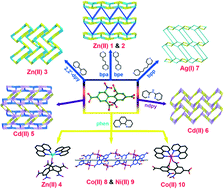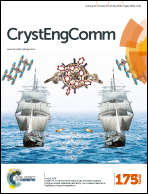Reaction-determined assemblies of 0D to 3D complexes: structural diversities and luminescence properties†
Abstract
Reaction-determined assemblies of 6,6′-dinitrobiphenyl-2,2′,4,4′-tetracarboxylic acid (H4nbtc), various N-donor ligands and transition metal ions produce ten complexes, namely, [Zn2(nbtc)(bpa)·H2O]n (1), [Zn2(nbtc)(bpe)·H2O]n (2), [Zn2(nbtc)(2,2′-dpy)]n (3), Zn(H3nbtc)(phen)2 (4), {(H3O)2[Cd3(nbtc)2(H2O)3]·5H2O}n (5), [Cd2(nbtc)(ndpy)·0.5H2O]n (6), [Ag2(H2nbtc)(bpp)]n (7), [Co2(nbtc)(phen)2(H2O)2]n (8), [Ni2(nbtc)(phen)2(H2O)2]n (9) and Co(H2nbtc)(phen)2·2H2O (10) (bpa = 1,2-bis(4-pyridyl)ethane, bpe = 1,2-di(4-pyridyl)ethylene, bpp = 1,3-bis(4-pyridyl)propane, 2,2′-dpy = 2,2′-dipyridyl, phen = 1,10-phenanthroline, ndpy = 2-pyridinamine). Isostructural 1 and 2 feature 3D “bilayered-pillared” frameworks constructed from Zn2(μ2-COO)2(μ1-COO)2-nbtc4− wave-bilayers and bpa/bpe pillars. Unlike 1 and 2, both 3 and 6 exhibit 3D “brick-wall” frameworks constructed from nbtc4− and various SBUs (0D Zn2(μ2-COO)3(μ1-COO)1 for 3, 1D [Cd2(μ2-COO)4]n for 6). However, 3D 5 can be viewed as a combination of 2D “brick-wall” layers and 1D [Cd3-nbtc] chains. Moreover, in comparison to neutral 3 and 6 with pensile and cosmetic terminal ligands, complex 5 without an N-donor ligand is particularly interesting, containing two hydronium ions to balance the anion unit [Cd3(nbtc)2(H2O)3]2− as well as three types of coordinated Cd(II) ions (6-, 7- and 8-). Unlike 3, complex 4 is mononuclear, despite the two complexes employing similar terminal ligands (2,2′-dpy for 3, phen for 4). In 2D layered Ag(I) 7, the 0D Ag4(μ2-COO)4 SBUs initially form Ag4(μ2-COO)4-H2nbtc2− chains before being bridged by bpp ligands. Isostructural Co(II) 8 and Ni(II) 9 exhibit 1D looped infinite chains. Structural comparisons indicate that the SBUs, the coordination modes of the H4nbtc ligand, the synthetic conditions and the nature of the N-donor ligands are crucial factors with respect to the structures of these compounds. Furthermore, the luminescence properties of 1–7 were investigated in the solid state at room temperature.


 Please wait while we load your content...
Please wait while we load your content...